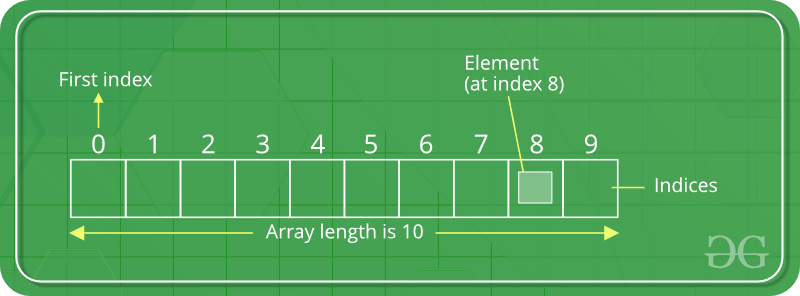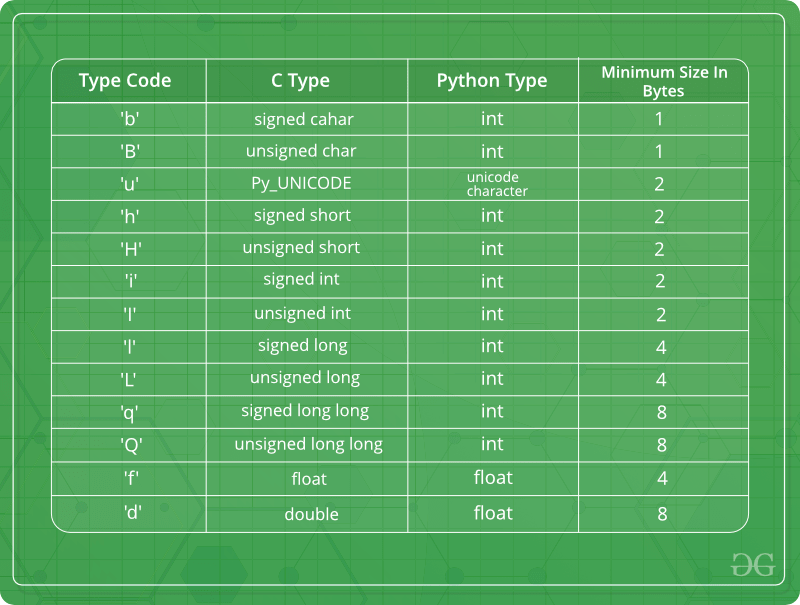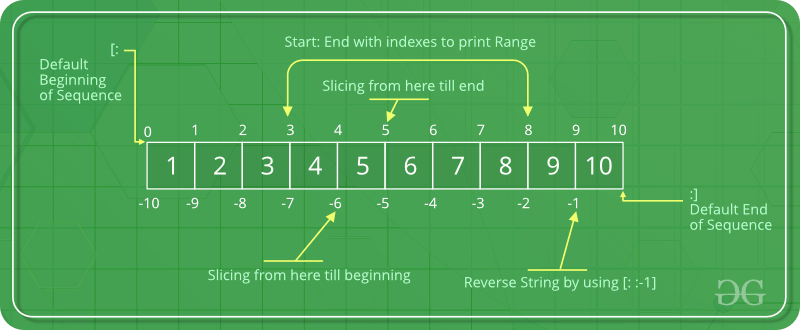An array is a collection of items stored at contiguous memory locations. The idea is to store multiple items of the same type together. This makes it easier to calculate the position of each element by simply adding an offset to a base value, i.e., the memory location of the first element of the array (generally denoted by the name of the array).
For simplicity, we can think of an array a fleet of stairs where on each step is placed a value (let’s say one of your friends). Here, you can identify the location of any of your friends by simply knowing the count of the step they are on. Array can be handled in Python by a module named array. They can be useful when we have to manipulate only a specific data type values. A user can treat lists as arrays. However, user cannot constraint the type of elements stored in a list. If you create arrays using the array module, all elements of the array must be of the same type.

Tóm Tắt
Creating a Array
Array in Python can be created by importing array module. array(data_type, value_list) is used to create an array with data type and value list specified in its arguments.
Python3
import array as arr
a = arr.array('i', [1, 2, 3])
print ("The new created array is : ", end =" ")
for i in range (0, 3):
print (a[i], end =" ")
print()
b = arr.array('d', [2.5, 3.2, 3.3])
print ("The new created array is : ", end =" ")
for i in range (0, 3):
print (b[i], end =" ")
Output :
The new created array is : 1 2 3 The new created array is : 2.5 3.2 3.3
Complexities for Creation of Arrays:
Time Complexity: O(1)
Auxiliary Space: O(n)
Some of the data types are mentioned below which will help in creating an array of different data types.

Adding Elements to a Array
Elements can be added to the Array by using built-in insert() function. Insert is used to insert one or more data elements into an array. Based on the requirement, a new element can be added at the beginning, end, or any given index of array. append() is also used to add the value mentioned in its arguments at the end of the array.
Python3
import array as arr
a = arr.array('i', [1, 2, 3])
print ("Array before insertion : ", end =" ")
for i in range (0, 3):
print (a[i], end =" ")
print()
a.insert(1, 4)
print ("Array after insertion : ", end =" ")
for i in (a):
print (i, end =" ")
print()
b = arr.array('d', [2.5, 3.2, 3.3])
print ("Array before insertion : ", end =" ")
for i in range (0, 3):
print (b[i], end =" ")
print()
b.append(4.4)
print ("Array after insertion : ", end =" ")
for i in (b):
print (i, end =" ")
print()
Output :
Array before insertion : 1 2 3 Array after insertion : 1 4 2 3 Array before insertion : 2.5 3.2 3.3 Array after insertion : 2.5 3.2 3.3 4.4
Complexities for Adding elements to the Arrays:
Time Complexity: O(1)/O(n) ( O(1) – for inserting elements at the end of the array, O(n) – for inserting elements at the beginning of the array and to the full array
Auxiliary Space: O(1)
Accessing elements from the Array
In order to access the array items refer to the index number. Use the index operator [ ] to access an item in a array. The index must be an integer.
Python3
import array as arr
a = arr.array('i', [1, 2, 3, 4, 5, 6])
print("Access element is: ", a[0])
print("Access element is: ", a[3])
b = arr.array('d', [2.5, 3.2, 3.3])
print("Access element is: ", b[1])
print("Access element is: ", b[2])
Output :
Access element is: 1 Access element is: 4 Access element is: 3.2 Access element is: 3.3
Complexities for accessing elements in the Arrays:
Time Complexity: O(1)
Auxiliary Space: O(1)
Removing Elements from the Array
Elements can be removed from the array by using built-in remove() function but an Error arises if element doesn’t exist in the set. Remove() method only removes one element at a time, to remove range of elements, iterator is used. pop() function can also be used to remove and return an element from the array, but by default it removes only the last element of the array, to remove element from a specific position of the array, index of the element is passed as an argument to the pop() method.
Note – Remove method in List will only remove the first occurrence of the searched element.
Python3
import array
arr = array.array('i', [1, 2, 3, 1, 5])
print ("The new created array is : ", end ="")
for i in range (0, 5):
print (arr[i], end =" ")
print ("\r")
print ("The popped element is : ", end ="")
print (arr.pop(2))
print ("The array after popping is : ", end ="")
for i in range (0, 4):
print (arr[i], end =" ")
print("\r")
arr.remove(1)
print ("The array after removing is : ", end ="")
for i in range (0, 3):
print (arr[i], end =" ")
Output:
The new created array is : 1 2 3 1 5 The popped element is : 3 The array after popping is : 1 2 1 5 The array after removing is : 2 1 5
Complexities for Removing elements in the Arrays:
Time Complexity: O(1)/O(n) ( O(1) – for removing elements at the end of the array, O(n) – for removing elements at the beginning of the array and to the full array
Auxiliary Space: O(1)
Slicing of a Array
In Python array, there are multiple ways to print the whole array with all the elements, but to print a specific range of elements from the array, we use Slice operation. Slice operation is performed on array with the use of colon(:). To print elements from beginning to a range use [:Index], to print elements from end use [:-Index], to print elements from specific Index till the end use [Index:], to print elements within a range, use [Start Index:End Index] and to print whole List with the use of slicing operation, use [:]. Further, to print whole array in reverse order, use [::-1].

Python3
import array as arr
l = [1, 2, 3, 4, 5, 6, 7, 8, 9, 10]
a = arr.array('i', l)
print("Initial Array: ")
for i in (a):
print(i, end =" ")
Sliced_array = a[3:8]
print("\nSlicing elements in a range 3-8: ")
print(Sliced_array)
Sliced_array = a[5:]
print("\nElements sliced from 5th "
"element till the end: ")
print(Sliced_array)
Sliced_array = a[:]
print("\nPrinting all elements using slice operation: ")
print(Sliced_array)
Output
Initial Array:
1 2 3 4 5 6 7 8 9 10
Slicing elements in a range 3-8:
array('i', [4, 5, 6, 7, 8])
Elements sliced from 5th element till the end:
array('i', [6, 7, 8, 9, 10])
Printing all elements using slice operation:
array('i', [1, 2, 3, 4, 5, 6, 7, 8, 9, 10])
Searching element in a Array
In order to search an element in the array we use a python in-built index() method. This function returns the index of the first occurrence of value mentioned in arguments.
Python3
import array
arr = array.array('i', [1, 2, 3, 1, 2, 5])
print ("The new created array is : ", end ="")
for i in range (0, 6):
print (arr[i], end =" ")
print ("\r")
print ("The index of 1st occurrence of 2 is : ", end ="")
print (arr.index(2))
print ("The index of 1st occurrence of 1 is : ", end ="")
print (arr.index(1))
Output:
The new created array is : 1 2 3 1 2 5 The index of 1st occurrence of 2 is : 1 The index of 1st occurrence of 1 is : 0
Complexities for searching elements in the Arrays:
Time Complexity: O(n)
Auxiliary Space: O(1)
Updating Elements in a Array
In order to update an element in the array we simply reassign a new value to the desired index we want to update.
Python3
import array
arr = array.array('i', [1, 2, 3, 1, 2, 5])
print ("Array before updation : ", end ="")
for i in range (0, 6):
print (arr[i], end =" ")
print ("\r")
arr[2] = 6
print("Array after updation : ", end ="")
for i in range (0, 6):
print (arr[i], end =" ")
print()
arr[4] = 8
print("Array after updation : ", end ="")
for i in range (0, 6):
print (arr[i], end =" ")
Output:
Array before updation : 1 2 3 1 2 5 Array after updation : 1 2 6 1 2 5 Array after updation : 1 2 6 1 8 5
Complexities for updating elements in the Arrays:
Time Complexity: O(n)
Auxiliary Space: O(1)
My Personal Notes
arrow_drop_up